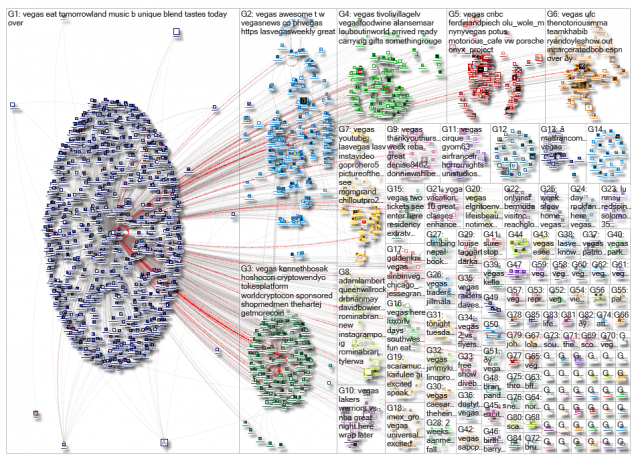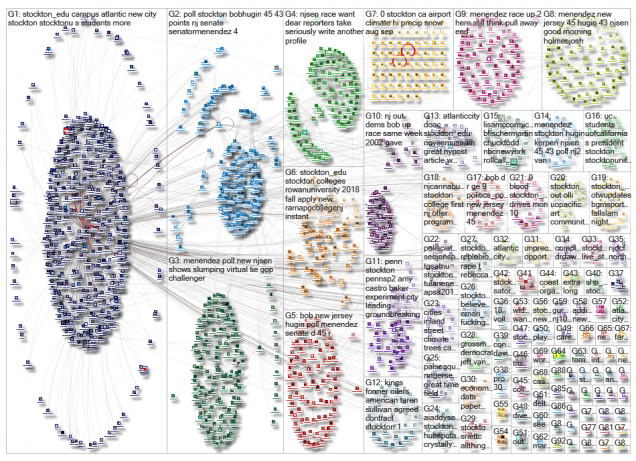In the Networked: the new social operating system, Rainie and Wellman (2012), emphasized the importance of being connected online as the most powerful tool in the new adage nowadays. As social media provides us a platform for self-expression, we are able to generate the platform into our personalized space with those we connect with. Rainie and Wellman have also stated that through the platforms, networked individuals can create their own content to influence others for a sense of empowerment.
With the categorized six types of Twitter topic networks by Smith et al. (2014), I identified two graphs on NodeXL gallery. The two graphs both present the freedom of user-generated content on Twitter, as well as their behavior of self-expression and empowerment.
Vegas
The graph represents a network of 2,198 Twitter users whose tweets in the requested range contained “@Vegas”, or who were replied to or mentioned in those tweets. In my view, the network graph is most closed to Community Clusters. The hashtags in this network includes #vegas, #lasvegas, #somethingrouge, #vegasstrong, #tennis, #talktennis, and #vegasstronger. These topics can mostly be identified as popular topics on Twitter, and the connections. According to Smith et al, “some popular topics may develop multiple smaller groups, which often form around a few hubs each with its own audience, influencers, and sources of information”. The topic around “#vegas” is originally a relatively broad topic, however, with individuals within this topic developing, the community gradually expanded to other hashtags as well as interconnected into other subgroups with smaller influencers and more closely related. After the mass shooting in 2017 at Harvest music festival, the topic started to include the content about #vegasstrong, and discussions that are related to gun violence. In this graph, we can see the trend of users’ opinion shifted and developed based on real-time news and events.
The information and network of this graph synchronize with the opinion of Rainie and Wellman, that social media influencers tend to spread their own opinionized information, which has more influence on their own community (2012). The top influencer in this graph is the Twitter account called “@vegas”, which can be perceived as the “official account” of City of Las Vegas. The account is mentioned or tagged in the largest cloud in this network, providing the largest influence for this topic. In my opinion, the key point of infomediation(Smyrnaios, 2018), is to have a “space” or a medium for the creators to self-express themselves and fill up this “space” voluntarily. The Vegas graph, at some level, perfectly depicts the diversity and freedom of creating content on social media, where under a larger group, content creators (which are internet users) slowly develop into smaller groups under the “leadership” of several influencers.

Stockton University
Another graph I found interesting was the one relates to Stockton University. The graph represents a network of 2,105 Twitter users whose tweets in the requested range contained “Stockton_edu OR #ChooseStockton “, or who were replied to or mentioned in those tweets. Top hashtags include #njsen, #stocktonu, #stocktonac, #atlanticcity, and #stockton.
In my view, this graph can be defined as Support Network. In this network, most participants are connected to the top influencer, which is the official account of Stockton University, @stockton_edu. The account is linked to most of the users in this graph, and the network developed several clusters that are more connected to others. Those accounts are not only interacting with the top influencer about university-related matters, but also extending the topic heavily to politics. We can see this by examining the top hashtags such as #njsen, and Bob Hugin, US senate candidate in New Jersey is mentioned a lot in this network.
I think this graph perfectly matches with the opinion of Smyrnaios in his book Internet Oligopoly, that “platforms become infomediaries when they generate complex sets of signifiers that make sense for humans in their social and political context”. The dataset was originally focused on Stockton University and its related matters, but as Twitter users developing their own content and expressing their opinions on university, politics, and the environment, the group gradually grows into several interconnected clouds. They all have different topics to discuss, all based on one geographic location (New Jersey). To me, it’s the beauty of user-generated context, and the most important power that social media has given us.

Reference
Rainie, H., & Wellman, Barry. (2012). Networked: The new social operating system. Cambridge, Mass.: MIT Press.
Smith, M. A., Rainie, L., Shneiderman, B., & Himelboim, I. (2014). Mapping Twitter topic networks: From polarized crowds to community clusters. Pew Research Center. Retrieved from http://www.pewinternet.org/2014/02/20/mapping-twitter-topic-networks-from-polarized-crowds-to-community-clusters/
Smyrnaios, N. (2018). Internet oligopoly: The corporate takeover of our digital world. Bingley: Emerald Group Publishing.